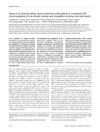Identificador persistente para citar o vincular este elemento:
https://accedacris.ulpgc.es/handle/10553/6509
| Title: | Strong iron demand during hypoxia-induced erythropoiesis is associated with down-regulation of iron-related proteins and myoglobin in human skeletal muscle | Authors: | Robach, Paul Cairo, Gaetano Gelfi, Cecilia Bernuzzi, Francesca Pilegaard, Henriette Vigano, Agnese Santambrogio, Paolo Cerretelli, Paolo Calbet, Jose A. L. Moutereau, Stéphane Lundby, Carsten |
UNESCO Clasification: | 2411 Fisiología humana | Keywords: | Blood Iron Altitude |
Issue Date: | 2007 | Journal: | Blood | Abstract: | Iron is essential for oxygen transport because it is incorporated in the heme of the oxygen-binding proteins hemoglobin and myoglobin. An interaction between iron homeostasis and oxygen regulation is further suggested during hypoxia, in which hemoglobin and myoglobin syntheses have been reported to increase. This study gives new insights into the changes in iron content and iron-oxygen interactions during enhanced erythropoiesis by simultaneously analyzing blood and muscle samples in humans exposed to 7 to 9 days of high altitude hypoxia (HA). HA up-regulates iron acquisition by erythroid cells, mobilizes body iron, and increases hemoglobin concentration. However, contrary to our hypothesis that muscle iron proteins and myoglobin would also be up-regulated during HA, this study shows that HA lowers myoglobin expression by 35% and down-regulates iron-related proteins in skeletal muscle, as evidenced by decreases in L-ferritin (43%), transferrin receptor (TfR; 50%), and total iron content (37%). This parallel decrease in L-ferritin and TfR in HA occurs independently of increased hypoxia-inducible factor 1 (HIF-1) mRNA levels and unchanged binding activity of iron regulatory proteins, but concurrently with increased ferroportin mRNA levels, suggesting enhanced iron export. Thus, in HA, the elevated iron requirement associated with enhanced erythropoiesis presumably elicits iron mobilization and myoglobin down-modulation, suggesting an altered muscle oxygen homeostasis. | URI: | https://accedacris.ulpgc.es/handle/10553/6509 | ISSN: | 0006-4971 | DOI: | 10.1182/blood-2006-08-040006 | Source: | Blood[ISSN 0006-4971],v. 109 (11), p. 4724-4731 |
| Appears in Collections: | Artículos |
Show full item record
SCOPUSTM
Citations
114
checked on Jun 8, 2025
WEB OF SCIENCETM
Citations
107
checked on Jun 8, 2025
Page view(s)
103
checked on Jan 11, 2025
Download(s)
340
checked on Jan 11, 2025
Google ScholarTM
Check
Altmetric
Share
Export metadata
This item is licensed under a Creative Commons License

